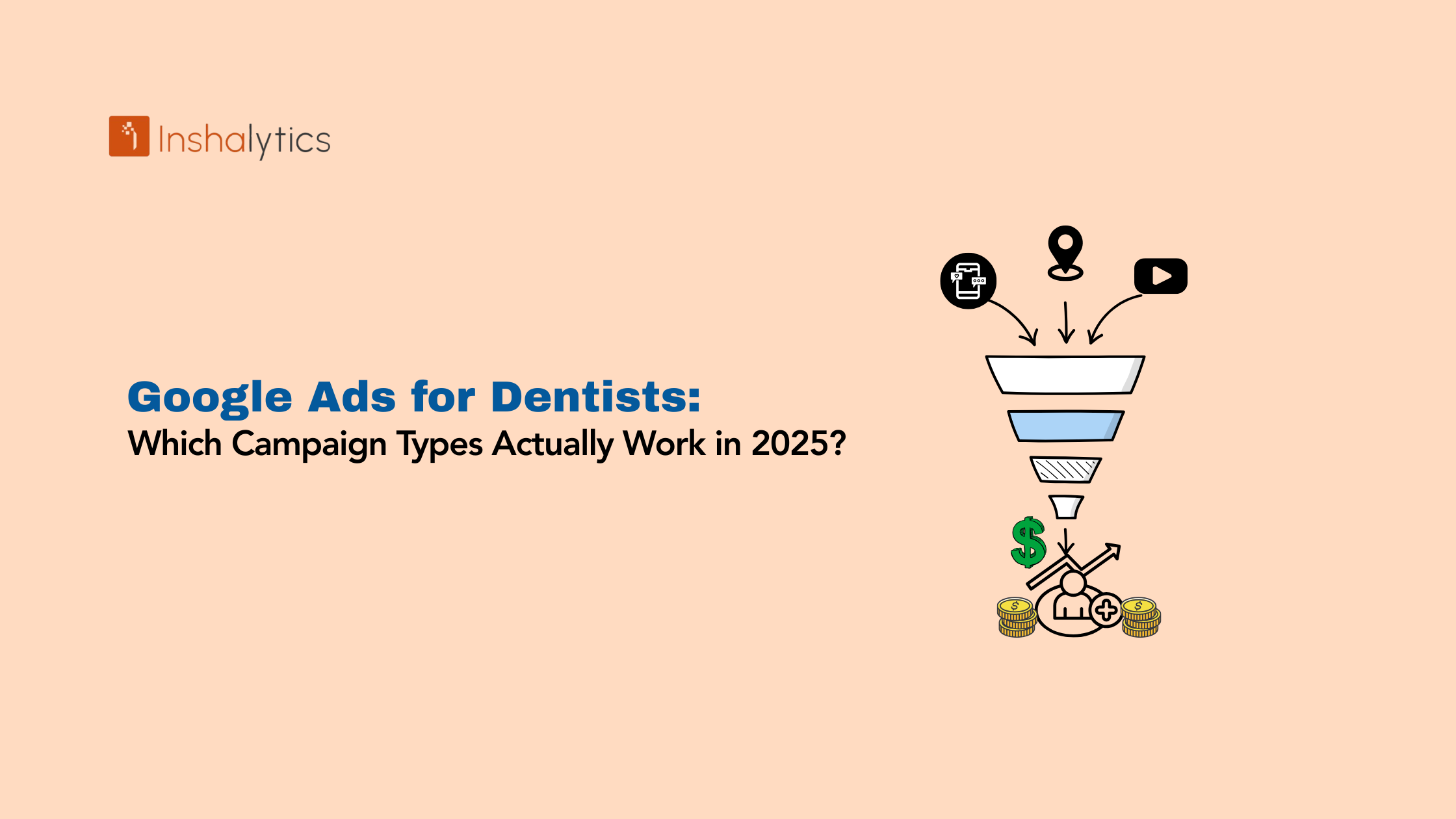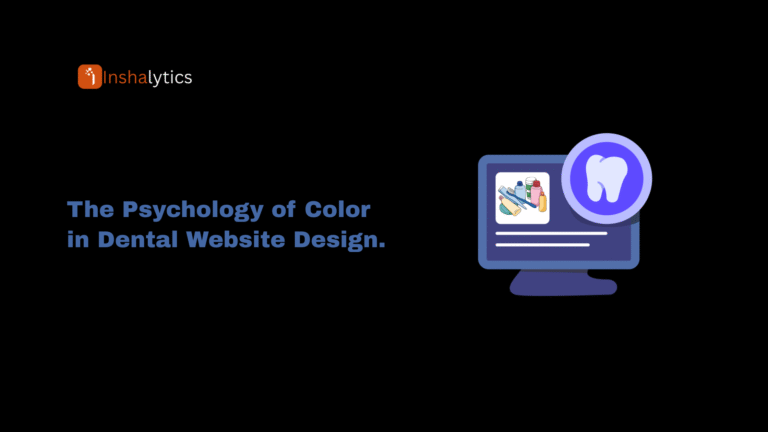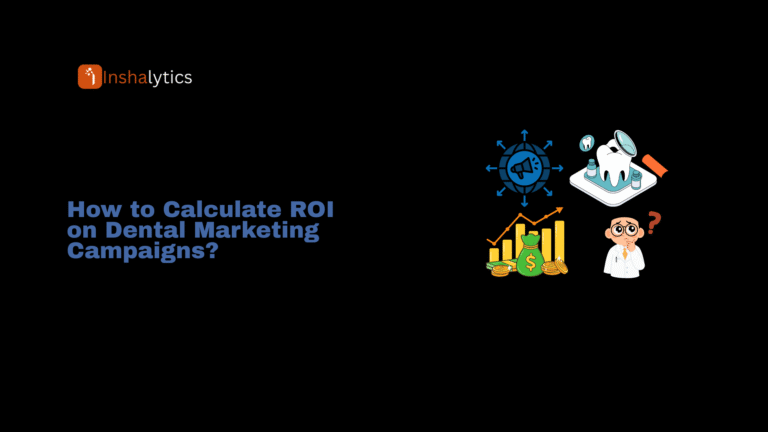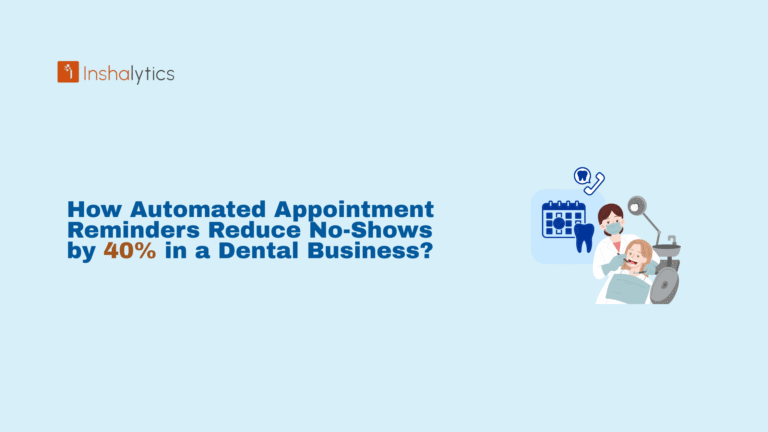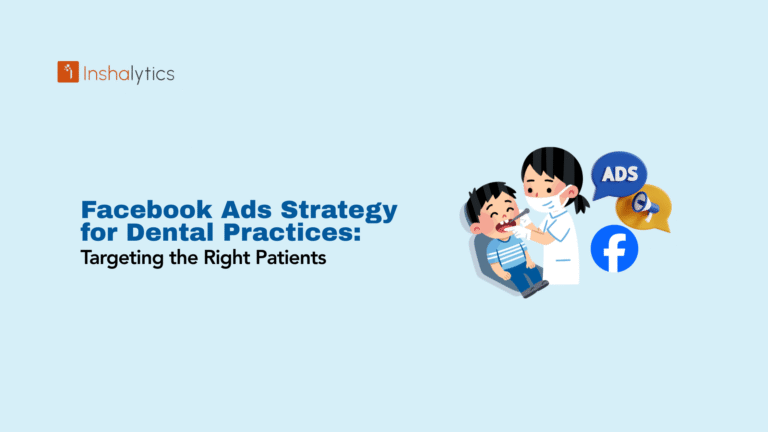Running Google Ads for your dental practice shouldn’t feel like throwing money into a black hole. Yet many dentists struggle with the platform because they’re using the wrong campaign types or spreading their budget too thin across strategies that don’t convert.
The truth is, not all Google Ads campaigns are created equal for dental practices. Some will flood your phone lines with qualified appointment requests, while others drain your budget with zero bookings to show for it.
In this comprehensive guide, we’ll break down exactly which Google Ads campaign types actually work for dentists in 2025, which ones to avoid, and how to structure your advertising strategy for maximum return on investment.
Why Google Ads Performance Matters for Dental Practices?
Before we dive into specific campaign types, let’s establish why getting this right matters so much for your practice.
Recent data from 2025 shows that dental Google Ads campaigns achieve an average conversion rate of 9.08%, meaning nearly one in ten clicks becomes a lead. The average cost per lead sits at approximately $83.93, though this varies significantly based on location and service type.
When properly optimized, dental practices consistently see ROI figures between 300% and 500%. That’s not just impressive, it’s practice-changing. A well-managed Google Ads strategy can be the difference between empty chairs and a fully booked schedule.
However, competition has intensified considerably. More dental practices are investing in digital advertising, which has driven up cost-per-click rates across major metropolitan areas. In cities like London, New York, or Los Angeles, CPCs for competitive keywords can range from $5 to $15 or higher.
This increased competition makes campaign selection even more critical. You can’t afford to waste budget on campaign types that look good on paper but don’t actually drive appointments.
Search Campaigns: The Highest-Converting Option for Dentists
If you’re going to invest in just one campaign type, make it Search Campaigns. These are the text ads that appear at the top of Google search results when someone types in queries like “dentist near me” or “emergency tooth repair.”
Why Search Ads Capture High-Intent Patients?
Search campaigns work exceptionally well for dentists because they target people at the exact moment they’re looking for dental services. Someone searching “cosmetic dentist in Chicago” isn’t casually browsing; they have a specific need and are ready to take action.
This high intent translates directly into better conversion rates. Unlike display ads that interrupt someone’s browsing experience, search ads provide a solution to an active problem. The user is already in “find a dentist” mode, making them far more likely to click through and book an appointment.
Search campaigns also offer superior targeting precision. You can bid on keywords tied to specific services like dental implants, teeth whitening, or emergency care. This allows you to create highly relevant ad copy that speaks directly to what the searcher needs.
Geographic Targeting for Local Patient Acquisition
One of the search campaigns’ most powerful features for dental practices is geographic targeting. You can set your ads to show only to people within a specific radius of your practice, ensuring you’re not wasting money on clicks from people who’ll never actually visit.
This is particularly valuable for emergency dental searches. When someone searches “emergency dentist near me open now,” they’re looking for immediate local help. By combining location targeting with time-based ad scheduling, you can ensure your ads appear exactly when and where they’ll be most effective.
Local keyword variations like “pediatric dentist in Austin” or “dental implants specialist Los Angeles” allow you to dominate your specific market without competing nationally. These location-specific terms often have lower CPCs than generic keywords while delivering highly qualified traffic.
Keyword Match Types That Actually Drive Appointments
Within search campaigns, your keyword match type strategy makes or breaks performance. Google offers three main options: exact match, phrase match, and broad match.
For dentists working with limited budgets, exact match and phrase match deliver the best results. An exact match ensures your ad only appears when someone searches for your specific keyword or a very close variation. This provides maximum control and eliminates wasted spend on irrelevant searches.
Phrase match offers slightly more flexibility, showing your ad when someone includes your keyword within a longer search phrase. This can help you capture variations you might not have thought of while still maintaining relevance.
Broad match should be approached cautiously. While it can uncover new keyword opportunities, it often triggers your ads on tangentially related searches that don’t convert. If you use broad match at all, pair it with a comprehensive negative keyword list to filter out irrelevant traffic.
Local Services Ads (LSAs): Dominating Local Search Results
Local Services Ads represent one of the most valuable advertising opportunities for dentists, yet many practices overlook them entirely. These ads appear even above traditional search ads, in a dedicated section at the very top of search results.
How LSAs Differ from Traditional Search Ads?
Unlike standard Google Ads that operate on cost-per-click, LSAs use a pay-per-lead model. You only pay when someone contacts your practice directly through the ad, whether by phone call or message. This fundamentally changes the risk equation in your favor.
LSAs also require verification and licensing checks through Google, which means appearing as a Local Services Ad carries implicit credibility. The “Google Guaranteed” or “Google Screened” badge that accompanies these ads builds immediate trust with potential patients.
The ad format itself is designed for maximum conversion potential. LSAs prominently display your practice name, rating, number of reviews, hours, and location, with a large call button that makes contacting you effortless.
Cost Structure and Lead Quality Comparison
Lead costs for LSAs tend to be higher per contact than cost-per-click for search ads, but the quality is typically superior. Because users are contacting you directly rather than just visiting your website, they’re further along in the decision-making process.
This direct contact model also eliminates the variable of landing page quality. With traditional search ads, you pay for the click, whether or not your landing page converts. With LSAs, you’re essentially paying for appointments or consultation requests directly.
The qualification process for LSAs means you’re competing in a more limited pool of verified providers. This can actually work to your advantage in less saturated markets, where getting verified might place you among only a handful of competitors appearing in these premium positions.
Combining LSAs with Search Campaigns
The most effective dental advertising strategies use both LSAs and search campaigns in tandem. LSAs capture the highest-intent traffic at the very top of results, while search campaigns fill in the gaps and allow for more granular targeting by service type.
This two-tier approach maximizes your visibility on the search results page. When a potential patient searches for dental services in your area, seeing your practice in both the Local Services section and the paid search ads section dramatically increases brand recognition and click-through probability.
Budget allocation should typically favor LSAs if you must choose, as they deliver more direct conversion opportunities. However, search campaigns offer valuable retargeting data and allow you to promote specific high-margin services that LSAs don’t always accommodate.
Call-Only Campaigns: Converting Mobile Searchers Instantly
Call-only campaigns are purpose-built for mobile devices and display only a phone number with no website link. For dental practices, this campaign type can be incredibly effective for specific use cases.
When to Use Call-Only vs. Standard Search Ads?
Call-only campaigns excel in emergency dental situations. When someone searches “emergency dentist open now” on their phone, they don’t want to browse your website; they want to call immediately. Call-only ads remove friction from this process.
These campaigns also perform well for practices that have strong phone conversion processes but weaker website experiences. If your front desk team is excellent at converting calls into appointments but your website doesn’t convert well, call-only campaigns play to your strengths.
The downside is that call-only campaigns don’t build retargeting audiences or allow for follow-up with users who weren’t ready to commit during their initial search. They’re purely conversion-focused with no brand-building component.
Optimizing for Emergency Dental Searches
Emergency keywords represent some of the highest-value, highest-intent searches in the dental space. Terms like “broken tooth repair,” “emergency tooth extraction,” or “severe toothache relief” indicate immediate need and willingness to book.
Call-only campaigns are ideal for these searches because emergencies demand immediate response. Every second spent navigating a website is a second your potential patient might call a competitor instead.
Make sure your ad copy emphasizes availability and speed. Phrases like “Same-Day Appointments,” “Open Now,” or “24-Hour Emergency Line” remove doubt about whether you can actually help them right away.
Tracking Call Quality and Conversions
Proper call tracking is essential for call-only campaigns. Implement call recording and conversion tracking to understand which keywords and ads drive not just calls, but quality calls that convert into appointments.
Many calls from these campaigns will be quick information requests that don’t result in bookings. That’s normal, but you need to distinguish between valuable calls and junk calls in your metrics to accurately calculate ROI.
Consider using call tracking software that integrates with Google Ads to automatically feed conversion data back into the platform. This allows Google’s automated bidding systems to optimize for the calls that actually matter to your practice.
Display Campaigns: Building Awareness and Remarketing
Display campaigns show visual banner ads across millions of websites, apps, and YouTube. For dental practices, these rarely work as standalone patient acquisition strategies, but they have specific, valuable applications.
Remarketing to Website Visitors Who Didn’t Book
The primary value of display campaigns for dentists lies in remarketing. When someone visits your website but doesn’t book an appointment, display ads keep your practice visible as they browse other websites.
This repeated exposure builds familiarity and keeps you top-of-mind when they’re ready to make a decision. Dental services are often high-consideration purchases; people frequently research multiple practices before booking. Remarketing ensures you stay in the conversation.
Remarketing audiences can be segmented by the pages visitors viewed, allowing you to show ads for dental implants to people who visited your implants page, or cosmetic dentistry ads to those who browsed veneer information.
Cost-Effectiveness vs. Search Campaign Performance
Display campaigns typically have much lower CPCs than search campaigns, sometimes as low as $0.50 to $2.00 per click. However, these clicks convert at dramatically lower rates because users aren’t actively searching for dental services when they see your ad.
Think of display advertising as the top of your marketing funnel. It introduces your practice to people who might need dental services eventually, but it rarely drives immediate appointment bookings.
For this reason, display budgets should be significantly smaller than search budgets. A good starting ratio is allocating about 10-20% of your total Google Ads budget to display remarketing, with the bulk going to search and local services ads.
Best Practices for Display Creative
If you do run display campaigns, creative quality matters enormously. Your ads compete with every other display ad on the page for attention, so generic stock photos of smiling people won’t cut it.
Feature before-and-after photos of actual patients with permission if possible, showcase your team, or highlight specific promotions. Clear, bold text with a strong call-to-action works better than subtle, artistic approaches.
Keep your display campaigns focused on remarketing rather than cold prospecting. Trying to generate new patient appointments from people who’ve never heard of your practice via display ads is typically cost-prohibitive compared to search strategies.
Performance Max: Automated Multi-Channel Reach
Performance Max is Google’s newest campaign type that uses artificial intelligence to automatically distribute your ads across Search, Display, YouTube, Gmail, and Discovery. It’s generated significant buzz, but does it actually work for dentists?
AI-Powered Optimization Across Google Properties
Performance Max campaigns promise simplicity. You provide your assets—headlines, descriptions, images, videos—and Google’s AI determines where, when, and to whom to show your ads based on conversion likelihood.
In theory, this allows Google to find conversion opportunities you might miss with manual campaign management. The system can identify patterns in user behavior that indicate someone is likely to book a dental appointment, then show them your ad across whichever Google property they’re using.
For practices with strong conversion tracking and sufficient budget for the AI to learn, Performance Max can occasionally outperform traditional campaigns. The keyword is “occasionally,” and that depends heavily on your specific circumstances.
When Performance Max Makes Sense for Dental Practices?
Performance Max works best for practices that already have successful search campaigns and want to expand reach without manual complexity. It’s not a replacement for search campaigns but rather a complement.
Practices with excellent creative assets—professional photos, engaging videos, compelling patient testimonials—tend to see better Performance Max results. The campaign can leverage these assets across YouTube and Display in ways manual campaigns can’t easily replicate.
You need substantial conversion data for Performance Max to optimize effectively. If you’re only generating a few conversions per month, the AI doesn’t have enough information to learn what works. Stick with manual campaigns until you’re consistently driving at least 20-30 conversions monthly.
Limitations and Control Trade-offs
The major drawback of Performance Max is the loss of control. You can’t see exactly which placements your ads appear on, which search terms trigger them, or precisely how budget is allocated across channels.
For dentists who want to focus their budget specifically on emergency keywords or particular services, this lack of transparency is problematic. You might be paying for impressions on YouTube videos that generate zero appointments while missing out on valuable search traffic.
Many dental marketing experts recommend treating Performance Max as a testing ground rather than your primary strategy. Run it alongside dedicated search campaigns and compare performance before shifting significant budget.
Campaign Types That Don’t Work for Most Dentists
Not every Google Ads campaign type makes sense for dental practices. Some are better suited to e-commerce or national brands, and investing in them often means diverting budget from strategies that actually work.
Video Campaigns (Limited Direct Lead Generation)
Video campaigns on YouTube can build brand awareness, but they rarely drive direct appointment bookings. The intent level of someone watching a YouTube video is completely different from someone actively searching for a dentist.
Unless you have exceptional video content and a large budget specifically allocated to brand building, video campaigns typically underperform for dental practices. The production costs alone often exceed the value generated.
Discovery Campaigns (Lower Intent Audiences)
Discovery campaigns show ads in Gmail, YouTube’s home feed, and Google’s Discover feed. While these placements can reach large audiences, the users aren’t actively searching for dental services.
Like display campaigns, Discovery ads work better for products people might buy impulsively, rather than high-consideration services like dental care. The cost per conversion is typically much higher than search campaigns.
When to Skip Certain Campaign Types
If your monthly Google Ads budget is under $3,000, focus exclusively on search campaigns and LSAs. Only expand into other campaign types once these core strategies are optimized and you have a budget to experiment.
Small practices in competitive markets, especially, should resist the temptation to diversify too early. Better to dominate in search than to spread the budget across five campaign types that all underperform.
Creating Your Multi-Campaign Strategy
The most successful dental practices don’t rely on a single campaign type but rather orchestrate multiple campaigns working together. Here’s how to structure your approach.
Budget Allocation Across Campaign Types
A balanced strategy for a practice with a healthy advertising budget might allocate 40% to search campaigns, 30% to Local Services Ads, 20% to call-only campaigns for emergency services, and 10% to display remarketing.
These percentages should shift based on your specific situation. Practices in highly competitive markets might need to weight search campaigns more heavily, while those with strong local visibility might find LSAs deliver better ROI.
Start with search campaigns regardless of budget. Only add additional campaign types once your core search strategy is profitable and scaled to your capacity constraints.
Combining Campaigns for Maximum Coverage
The goal is to control as many search result real estate search results as possible. When someone searches “cosmetic dentist near me,” ideally, they see your LSA at the top, your search ad below that, and your organic listing further down the page.
This multi-touchpoint visibility dramatically increases click-through probability. Even if the user doesn’t click your first ad, seeing your practice name multiple times builds recognition and credibility.
Use different campaign types to target different patient journeys. LSAs capture ready-to-book patients, search campaigns allow you to promote specific services, call-only campaigns handle emergencies, and display remarketing nurtures those still in research mode.
Testing and Optimization Framework
Plan to spend your first 30-60 days gathering data rather than expecting immediate, perfect results. Google’s automated bidding strategies need conversion data to optimize effectively, which means early performance often improves substantially over time.
Test one variable at a time. If you change ad copy, bidding strategy, and targeting simultaneously, you won’t know which change drove performance shifts. Methodical testing yields better long-term results than constant tinkering.
Review performance weekly but make strategic changes monthly. Daily adjustments lead to overreaction to normal variance. Give changes time to accumulate meaningful data before judging their effectiveness.
Measuring Success: Tracking What Actually Matters
The metrics that matter for dental Google Ads are different from what Google’s interface highlights by default. Here’s what you should actually be tracking.
Setting Up Conversion Tracking (Calls, Forms, Appointments)
Proper conversion tracking is non-negotiable. You need to track phone calls from ads, contact form submissions, and ideally, actual booked appointments if your practice management software allows integration.
Without accurate conversion tracking, you’re flying blind. You might be spending heavily on keywords that drive clicks but zero appointments, while underfunding keywords that consistently bring in high-value patients.
Use Google’s call tracking numbers for any campaign that might drive phone calls. Set up separate tracking numbers for different campaigns so you can attribute which campaigns drive which calls.
Cost Per Patient vs. Cost Per Click
Cost per click is a vanity metric. What matters is the cost per new patient. A $10 CPC that converts at 20% is better than a $2 CPC that converts at 2%, even though the latter looks cheaper on the surface.
Calculate your patient lifetime value to understand how much you can afford to spend on acquisition. If the average patient stays with your practice for five years and generates $3,000 in revenue, you can likely afford to spend $200-300 to acquire them.
Track not just total new patients but new patients by service type. A new patient coming in for basic cleaning has a different lifetime value than someone booking dental implants. Service-specific tracking allows for service-specific bid optimization.
Lifetime Patient Value Considerations
The true ROI of Google Ads for dentists extends far beyond the initial appointment. A new patient who stays with your practice for years and refers friends represents exponentially more value than the initial acquisition cost.
This long-term perspective should inform your willingness to invest in Google Ads. Even if your initial cost per new patient seems high, the lifetime value calculation might reveal that these campaigns are highly profitable.
Consider tracking six-month and one-year retention rates for patients acquired through different campaigns. You might discover that patients from certain keywords or campaign types have higher lifetime value, which should influence your bidding strategy.
Conclusion: Building Your Winning Campaign Strategy
Not all Google Ads campaign types deliver equal results for dental practices. Search campaigns and Local Services Ads consistently drive the highest quality leads at the best cost efficiency. Call-only campaigns work exceptionally well for emergency dental services. Display campaigns serve a limited but valuable role in remarketing.
Performance Max, video campaigns, and Discovery campaigns should be considered only after your core search strategy is optimized and profitable. For most dental practices, these remain experimental at best.
The key to Google Ads success isn’t using every available campaign type—it’s mastering the ones that actually convert searchers into patients. Start with search campaigns, add LSAs when budget allows, and expand only after you’ve maximized returns from these proven strategies.
Focus on tracking the metrics that matter: cost per patient, patient lifetime value, and actual booked appointments rather than clicks or impressions. With proper tracking and optimization, Google Ads can be one of the most profitable patient acquisition channels for your dental practice in 2025.
